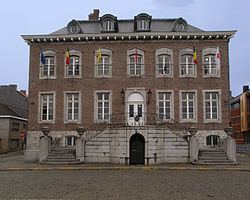Area codes 04 Local time Thursday 1:06 AM Area code 04 | Postal codes 4100, 4101, 4102 Website www.seraing.be | |
 | ||
Weather 12°C, Wind S at 14 km/h, 73% Humidity | ||
Seraing is a Walloon municipality of Belgium in Province of Liege. The municipality of Seraing includes the old communes of Boncelles, Jemeppe-sur-Meuse, and Ougrée. With Liège, Herstal, Saint-Nicolas, Ans, and Flémalle, it forms the greater Liège agglomeration (600,000 inhabitants). To the south of Seraing are the Condroz and the Ardennes regions.
Contents
- Map of Seraing Belgium
- Antiquity and Middle Ages
- Industrial development
- Recent developments
- Sights
- Folklore
- Notable people
- Twin townsSister cities
- References
Map of Seraing, Belgium
In addition to its steel factories, Seraing is home to the crystal manufacture Val Saint Lambert, which has been operating on the site of an old Cistercian abbey since 1826. The site of the Arcelor steel company, previously known as Cockerill-Sambre, is the former summer residence of the prince-bishops of Liège.
Antiquity and Middle Ages
Several skeletons, potshards, weapons, and jewels were discovered here, dating from the 5th and 6th century, attesting to Seraing being inhabited in Frankish times. The first mention of Saran dates from 956, when a Carolingian farming domain extending on both sides of the Meuse River and owned by someone named Saran was donated to the abbey of Sint-Truiden. The whole territory soon passed to the Bishopric of Liège. In the 11th century, Prince-Bishop Henri I of Verdun used a house in Seranus to entertain guests. Throughout the Middle Ages, the inhabitants of Seraing owed allegiance to Liège, pledging to defend the fluvial approach to the city in case of invasion, in exchange for tax exonerations. The first wooden bridge across the river, which replaced the ferry, was built in 1381.
Industrial development
The name of the town changed several times throughout its history, with the current spelling only being set in the 18th century. At around that time, various factors combined to attract industrial investors to Seraing: the advent of the Industrial Revolution, the proximity of the Meuse River, and the discovery of coal at Ougrée. The first ironworks were founded there in 1809. John Cockerill revolutionized the steel industry by using blast furnaces and coke instead of traditional charcoal. These inventions would be the basis for his new company, John Cockerill & Cie established in Seraing in 1817. Over the next decades, many more metallurgical plants and foundries were built in this area, which became an integral part of Wallonia's industrial backbone, the sillon industriel. Glassworkers found the proximity of a cheap source of coal attractive. The Val Saint Lambert started its operations in 1826.
Seraing was the first location in Belgium where The Church of Jesus Christ of Latter-day Saints built in Belgium. Work began on the building in 1927 and completed before the end of 1930.
Recent developments
In the 2012 Tour de France, Seraing acted as the finish of Stage 1.
Sights
Folklore
Notable people
Twin towns—Sister cities
Seraing is twinned with:
